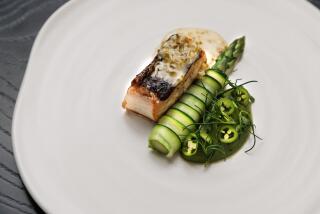There’s the Beef
- Share via
Why, good evening, your excellencies. We were being introduced to Consul Gen. Luis M. Riccheri of the Argentine Republic and a whole line of Argentine eminencies Saturday.
Then, before we knew it, we were in the bar of Riccheri’s Hancock Park residence, in a crowd of tuxedoed men and tall women in black dresses, all sipping Argentine wines. The reds were mostly made from Malbec, a Bordeaux variety that Argentina has made its own, and one of the whites was Torrontes, a Spanish variety that’s been grown in Argentina for 300 years.
The wines were all nicely fruity, partly because none of them (not even the Chardonnays) showed any sign of the oak flavor that has bedazzled California winemakers for the last 25 years.
But all this was mere prelude. The evening was about beef, of which Argentina has plenty--around 55 million head. Out in the backyard, Tom Arnold, a sometime cattleman himself when he’s not playing sitcom dad, was welcoming people to an Argentine asado, or beef feed.
While the crowd of 75 wandered and sipped on the lawn, an Argentine caterer out behind a hedge was shoveling huge, cinder-spitting chunks of fiercely glowing charcoal into a brazier about the size of a double bed loaded with the usual Argentine barbecue assortment: sweetbreads, blood sausages, chorizos (in this case, a 40%-beef sausage) and rib-eye steaks. Two pleased-looking guys from Gelson’s Markets were watching. Gelson’s is the only supermarket chain selling Argentine beef in our area.
The news was that Argentine beef is being imported at all. Washington wouldn’t allow it for many decades, largely for political reasons; Argentina’s political leanings were long of the wrong sort. Now the beef of the gauchos is back among us--not only at Gelson’s but at quite a few Argentine steakhouses.
After a brief stab in the direction of vegetables, the asado meal turned seriously to meat. Waiters started bringing trays of barbecue and kept on as long as anybody would have it. The beef was indeed excellent, abundantly beefy but not as marbled with fat as American beef. It also had a slightly denser texture because it comes from yearlings, 14 to 16 months old; American cattle are generally slaughtered at 20 to 28 months.
Surprisingly, the Argentine Beef Co. is promoting this heavy-duty beef as a health food. It dwells on the fact that Argentine cattlemen don’t use hormones, steroids and antibiotics and don’t fatten up their herds on grain in feed lots; the cattle spend their adult lives eating alfalfa out on the pampas. The company contends that grass-fed beef contains substantial levels of linolenic acid, an n-3 fatty acid, whereas grain-feed beef incline to n-6 fatty acids (we were unable to taste any acid, however).
Then when we were totally stuffed with beef came the tango. A small tango orchestra began playing for dancers who clearly weren’t digesting the kind of meal we’d just had. Argentines are evidently up for this kind of thing, because Melrose Avenue was blocked off the next morning for a tango festival, complete with barbecue. They played songs of tragic romance that day, but not for us.
More to Read
Eat your way across L.A.
Get our weekly Tasting Notes newsletter for reviews, news and more.
You may occasionally receive promotional content from the Los Angeles Times.










